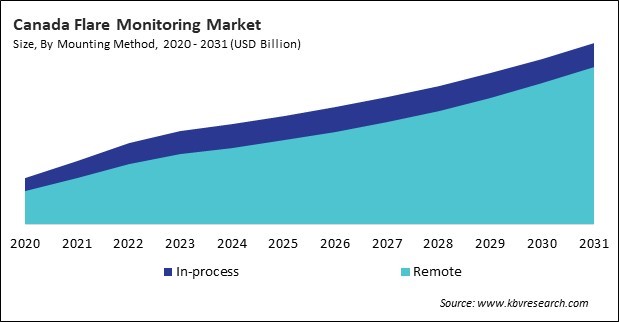The North America Flare Monitoring Market would witness market growth of 7.7% CAGR during the forecast period (2024-2031).
The US market dominated the North America Flare Monitoring Market by Country in 2023, and would continue to be a dominant market till 2031; thereby, achieving a market value of $455.8 million by 2031. The Canada market is experiencing a CAGR of 9.7% during (2024 - 2031). Additionally, The Mexico market would exhibit a CAGR of 9.1% during (2024 - 2031).

This refers to continuously tracking, analyzing, and reporting emissions produced during the flaring of excess gases in industrial operations. Flaring is a prevalent practice in industries such as oil and gas, petrochemicals, refineries, and chemical facilities. It involves the controlled combustion of gases that are not recoverable or usable in the production process. The primary objective of this is to minimize the environmental and health consequences of emitting pollutants while ensuring that flaring is conducted safely and efficiently.
Flares burn off gases released during production, processing, or storage, which could otherwise accumulate and pose safety hazards. However, flaring generates emissions that include greenhouse gases such as carbon dioxide (CO2) and methane (CH4), as well as other harmful pollutants like volatile organic compounds (VOCs), sulfur dioxide (SO2), and nitrogen oxides (NOx). Emissions like these contribute to air pollution, global warming, and hazards to public health, which is why it is necessary to monitor flare operations.
Mexico's oil and gas sector, particularly its refineries, drives the increasing demand for these systems. Pemex, the state-owned oil company, operates six major refineries, all of which have been under pressure to reduce emissions as part of the country's commitments under the Paris Agreement. The Mexican government has introduced environmental regulations, such as the NOM-085-SEMARNAT standard, which limits air pollution from refineries and industrial sources. The Secretariat of Environment and Natural Resources (SEMARNAT) oversees these initiatives and promotes using advanced monitoring systems to ensure compliance. In addition, Mexico’s Energy Transition Law encourages the use of clean technologies in energy production, providing a regulatory backdrop that indirectly fuels the demand for flare monitoring in the refining sector. Thus, the region will present lucrative growth prospects for the market throughout the forecast period.
Free Valuable Insights: The Flare Monitoring Market is Predict to reach USD 2 Billion by 2031, at a CAGR of 8.5%
Based on Mounting Method, the market is segmented into In-process (Gas Chromatographs, Mass Spectrometers, Flowmeters, Calorimeters, and Other In-process Type) and Remote (Thermal (IR) Imagers, Multi-Spectrum Infrared (MSIR) Imagers, and Other Remote Type). Based on Industry, the market is segmented into Refineries, Petrochemicals, Onshore Oil & Gas Production Sites, Landfills, and Other Industries. Based on countries, the market is segmented into U.S., Mexico, Canada, and Rest of North America.
By Mounting Method
By Industry
By Country
Our team of dedicated experts can provide you with attractive expansion opportunities for your business.

